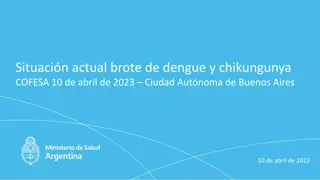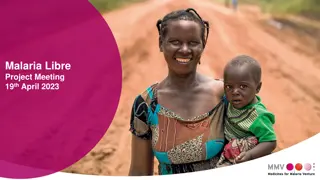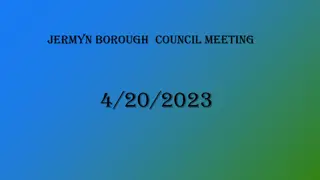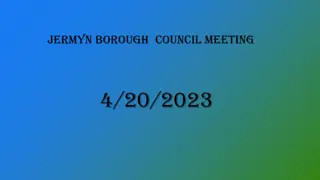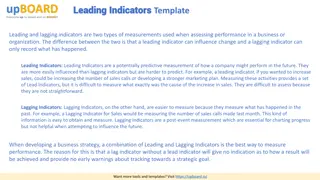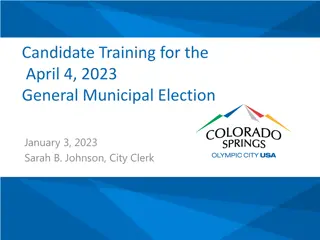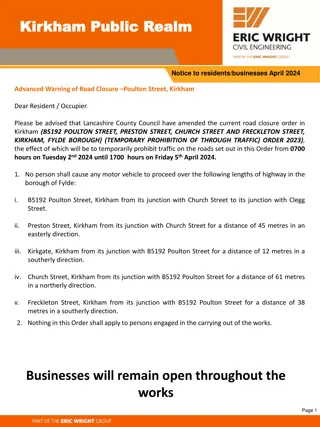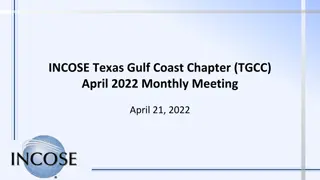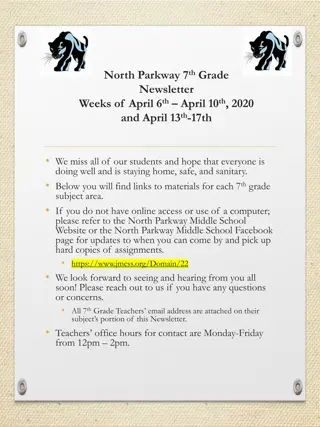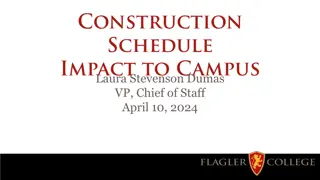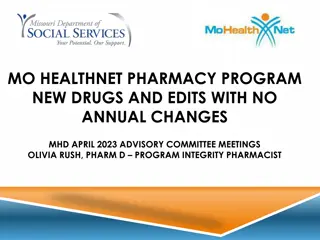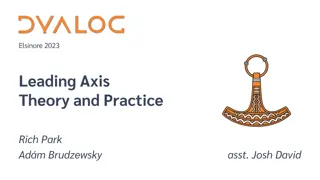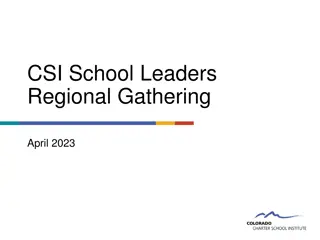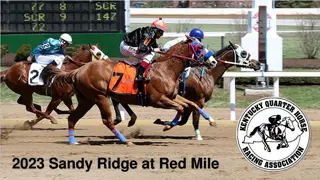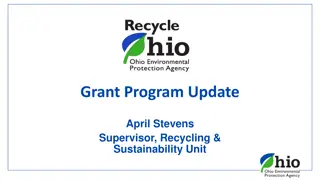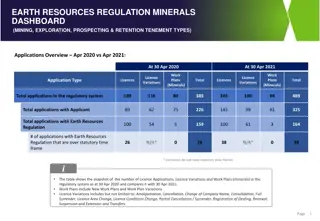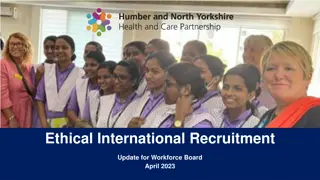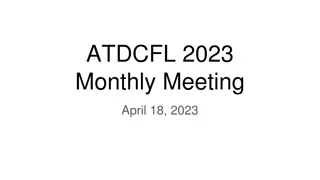
Effective Learning, Teaching, and Assessment Strategies for Success
Explore key ingredients for successful learning, teaching, and assessment at 2.3, including policies, self-evaluation processes, CLPL, assessment approaches, tracking systems, and more. Discover the importance of collaborative documents, pedagogical research, and robust evaluation practices. Enhance your understanding of authentic assessment approaches, monitoring systems, and engaging parents in the learning process.
Download Presentation

Please find below an Image/Link to download the presentation.
The content on the website is provided AS IS for your information and personal use only. It may not be sold, licensed, or shared on other websites without obtaining consent from the author. If you encounter any issues during the download, it is possible that the publisher has removed the file from their server.
You are allowed to download the files provided on this website for personal or commercial use, subject to the condition that they are used lawfully. All files are the property of their respective owners.
The content on the website is provided AS IS for your information and personal use only. It may not be sold, licensed, or shared on other websites without obtaining consent from the author.
E N D
Presentation Transcript
2.3 LEARNING, TEACHING AND ASSESSMENT
Session Aims: Discussion of the ingredients for success at 2.3 Highlighting Key Strengths: Key policies Self evaluation process CLPL Assessment approach Tracking, monitoring and reporting supporting parents Moderation Looking outwards Inspection: Suite of evidence What are they looking for in classrooms? Supporting Staff QUESTIONS
2.3 Learning, Teaching & Assessment KEY POLICY Have a sound and robust L&T policy* which ensures a shared understanding across staff regards the features of an effective lesson. This will be supported and explained by relevant pedagogical research. This should be a collaborative document which has been co-created with staff through consultation and review before implementation. Pupils are part of the consultation process. There is an associated toolkit* to allow staff to implement the policy successfully accompanied by continuous CLPL *Policy and Toolkit documents available to access
Authentic and robust self- evaluation process* in place linked to T&L policy Self-Evaluation Process Process following lifting of Covid restrictions Collaborative approach offered to staff this session high uptake and positive feedback Detailed feedback using forms *Presentation on self-evaluation process available to access
CLPL A strong provision of in-house CLPL informed by recent pedagogical thinking, making use of in-person and online meetings. Teacher-led a culture of collaboration. T&L WORKING GROUP TOP TIP TUESDAYS TEACH MEETS T&L BULLETIN CAT AFTERNOONS
Approaches to Assessment A devised approach which has moved away from the traditional prelim Aiding mental health and learner/teacher approaches to assessment within the classroom Calendar of assessments shared in advance with pupils.
Tracking, monitoring and reporting supporting parents Sound tracking system which allows evidence of progression and recording of levels. Tracking system which considers protected characteristics and allows for judgement on the requirement of intervention AT RISK Planned calendar of tracking and reporting Online session for parents clarifying Levels and Judgement
HOLISTIC PLANNING OF LEARNING, TEACHING AND ASSESSMENT School The Royal High School Curricular Area / Subject Social Studies: History Stage (eg P5 / S1) S2 Block eg August - October January- May Date of planning 3 June 2019 Quality assured by CL Organisers, and Bundles of Experiences and Outcome Related Benchmarks Learning Intentions and Success Criteria Contexts for Learning Range of Learning Experiences and Assessment Evidence Literacy/Numeracy Es and Os Bundles Organiser: Events and Societies People, Past Learners will use a variety of primary and secondary sources including eyewitness testimony, film clips, images and websites to investigate the impact of the Holocaust on the Jewish people from looking at their life before the war to the effects on survivors. When I engage with others, I can make a relevant contribution, encourage others to contribute and acknowledge that they have the right to hold a different opinion. Learning Intentions Learning experiences Compares a range of primary and secondary sources of evidence, to present at least three valid conclusions about a historical period Provides at least two valid opinions about the possible motives of those involved in a significant turning point or event in history. Provides a valid opinion of the impact of this significant historical event We are learning to Pupils will: I can use my knowledge of a historical period to interpret the evidence and present an informed view. SOC 3-01a understand the variety of experiences of pre- war Jewish life Explain why the Nazi party targeted the Jews Describe the impact of Anti-semitic laws, life in the Ghettos, the Final Solution, transport and life in the camps Interpret images and draw conclusions Pull out information from text Teach each other in group tasks Watch, listen and interpret information I can respond in ways appropriate to my role and use contributions to reflect on, clarify or I can discuss the motives of those involved in a significant turning point in the past and assess the RATIONALE
Looking Outwards Valuable relationships looking outwards Magpie moments! Self-reflection Moving forwards, continuous improvement.
Suite of Evidence for 2.3 Inspection The T&L Policy and toolkit Digtial Policy Literacy and Numeracy Data (levels by year) Samples of the CPD sessions we have run for teachers the Teach Meet schedules. I included what we covered over covid too to keep staff upskilled Our T&L bulletin samples Digital Self Evaluation Docs (I used the Ed Scotland one) and our accreditation evidence for SELFIE and Apple School T&L Working Group minutes BOCSH discussion/visit minutes as evidence of looking outward Evidence of the work done by our Prof Learning Communities in the school Samples of progression through our reporting system showcasing where we are able to use the data to make interventions Samples from faculties of good Tracking and monitoring, quality assurance policies Moderation exemplars including digital moderation where possible Our self evaluation policy, training, participation and feedback Samples of how we identify pupils At Risk in our tracking and potential interventions targeted support.
What are they looking for? That your evaluation of T&L at your school correlates with what they see in classrooms T&L policy in action typically a 20-25 minute visit Relationships Awareness of needs and those needs being met Successfully differentiated classrooms and learning Pupils able to articulate purpose of learning, a knowledge of levels, engagement with progression Effective Questioning/Higher order skills Pupil-led activities/learning Use of digital technology (dependent on where you are in your journey with this!) Effective Learning intentions and success criteria, skills



